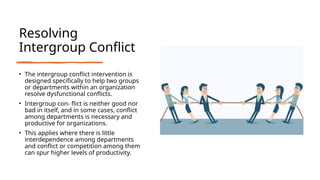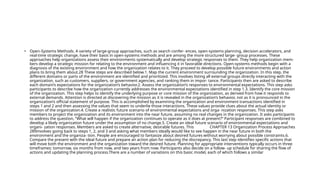Ad
DBA-ORGDEV case study and actions taken by organization
- 2. APPLICATION STAGES 1. Identify an issue. This step involves finding a systemwide problem to be addressed. 2. Convene the group. Once an issue is identified, the microcosm group can be formed. 3. Provide group training. Once the microcosm group is established, training is provided in group problem solving and decision making. 4. Address the issue. This step involves solving the problem and implementing solutions. 5. Dissolve the group. The microcosm group can be disbanded following successful implementation of changes.
- 3. Results of Microcosm Groups • The microcosm group intervention derives from an intergroup relations theory developed by Alderfer, who has applied it to communica- tions and race-relations problems. A microcosm group that addressed communications issues improved the way meetings were conducted; developed a job posting, career development, and promotion program; and conducted new- employee orientations.
- 4. Resolving Intergroup Conflict • The intergroup conflict intervention is designed specifically to help two groups or departments within an organization resolve dysfunctional conflicts. • Intergroup con- flict is neither good nor bad in itself, and in some cases, conflict among departments is necessary and productive for organizations. • This applies where there is little interdependence among departments and conflict or competition among them can spur higher levels of productivity.
- 5. Application Stage • A consultant external to the two groups obtains their agreement to work directly on improving intergroup relationships. • A time is set for the two groups to meet—preferably away from their normal work situations. • The consultant, together with the managers of the two groups, describes the purpose and objectives of the meeting • The two groups are assigned to separate rooms and asked to write their answers to the three questions. • After completing their lists, the two groups reconvene. A representative from each group presents the written statements. • When it is clear that the two groups thoroughly understand the content of the lists, they separate again. • The task of the two groups (almost always with a consultant as a process observer) is to analyze and review the reasons for the discrepancies. • When the two groups have worked through the discrepancies, as well as the areas of common agreement, they meet to share both the identified discrepancies and their problem-solving approaches to those discrepancies. • The two groups are asked to develop specific plans of action for solving specific problems and for improving their relationships. • When the two groups have gone as far as possible in formulating action plans, at least one follow-up meeting is scheduled so that the groups can report on actions that have been implemented, identify any further problems that have emerged, and, where necessary, formulate additional action plans.
- 6. Results of Intergroup Conflict Interventions • A number of studies have been done on the effects of intergroup conflict resolution. Positive results have been reported by several researchers in a variety of settings, including union–management relations, an Indian tribal council, government organizations, and for-profit firms.19 The results include attitudinal changes such as improved perceptions, increased trust, and less ste- reotyping in addition to improved operational results. For example, Huse found that bringing representatives of different groups together to work on common work-related problems had a marked effect, not only on relationships among a number of different manufacturing groups but also on the quality of the product, which increased 62%.20The technology for improving intergroup relations is promising. A greater distinc- tion between attitudinal and behavioral changes needs to be made in planning effective intergroup interventions. A greater variety of interventions that address the practical difficulties of bringing two groups together is also necessary. Finally, more knowledge is needed about how culture affects intergroup conflict and how interventions need to be adjusted in cross-cultural situations.21 Growing knowledge and theory suggest that conflict can be either functional or dysfunctional, depending on the circumstances. Further research is needed to identify when conflict should be intensified and when it should be reduced.LARGE-GROUP INTERVENTIONSThe third systemwide process intervention is called large-group intervention. Such
- 7. Application Stages • Preparing for the Large-Group Meeting A design team comprising OD practitioners and several organization members is formed to organize the event. The team gener- ally addresses three key ingredients for successful large-group meetings: a compelling meeting theme, appropriate participants, and relevant tasks to address the theme.1. Compelling meeting theme. Large-group interventions require a compelling reason or focal point for change. Although “people problems” can be an important focus, more powerful reasons for large-group efforts include managing impending mergers or reorganizations, responding to environmental threats and opportuni- ties, or proposing radical organizational changes.27 Whatever the focal point for change, senior leaders need to make clear to others the purpose of the large-group meeting. Ambiguity about the reason for the intervention can dissipate partici- pants’ energy and commitment to change. For example, a large-group meeting that successfully envisioned a hospital’s future organization design was viewed as a failure by a few key managers who thought that the purpose was to cut costs from the hospital’s budget. Their subsequent lack of support stalled the change effort.2. Appropriate participants. A fundamental goal of large-group interventions is to “get the whole system in the room.” This involves inviting as many people as possible who have a stake in the conference theme and who are energized and committed to conceiving and initiating change. Senior managers, suppliers, union leaders, internal and external customers, trade-group representatives, government and regulatory officials, and organization members from a variety of jobs, genders, races, and ages are potential participants.3. Relevant tasks to address the conference theme. As described below, these tasks typically are assigned to several subgroups responsible for examining the theme and drawing conclusions for action. Generally, participants rely on their own experience and expertise to address systemwide issues, rather than drawing on resources from outside of the large-group meeting. This ensures that the meet- ing can be completed within the allotted time and that members can participate fully as important sources of information.
- 8. • Conducting the Meeting The flow of events in a large-group meeting can vary greatly, depending on its purpose and the framework adopted. Most large-group pro- cesses, however, fit within three primary frameworks: open-systems methods, open- space methods, and positive methods. These various methods reflect different strategies for dealing with the four key dilemmas of large-group interventions:1. The dilemma of voice refers to the problem of encouraging participation on the one hand and being overwhelmed if each individual wants to speak. Even when a large-group event is relatively small in terms of participants, time would quickly run out if everyone wanted to speak up in the large group. 288 PART 3 Human Process Interventions2. The dilemma of structure refers to how tightly or loosely the meeting should be orga- nized. Some methods, like the open-systems processes described below, can be tightly controlled while others, like the open-space methods, are almost unstructured. The dilemma is not knowing how much structure a particular group prefers, how much they want, or how much anxiety they are experiencing.3. The egocentric dilemma refers to the problem of people holding on to their own personal views of right or wrong, better or worse. When individuals hold on too tightly, it makes large- group decision making difficult. When a large-group event overly represents one stakeholder group, that group can dominate the conversa- tion and be less open to alternative points of view.4. The dilemma of emotional contagion refers to a group dynamic where many people take on the frustrations or excitement of others. When emotional conta- gion happens, people unconsciously give up their ownership of a problem, action, or solution and get swept up in the moment. It represents a large-group version of “groupthink” and can result in solutions that people, upon reflection, cannot support.
- 9. • Open-Systems Methods. A variety of large-group approaches, such as search confer- ences, open-systems planning, decision accelerators, and real-time strategic change, have their basis in open-systems methods and are among the more structured large- group processes. These approaches help organizations assess their environments systematically and develop strategic responses to them. They help organization mem- bers develop a strategic mission for relating to the environment and influencing it in favorable directions. Open-systems methods begin with a diagnosis of the existing environment and how the organization relates to it. They proceed to develop possible future environments and action plans to bring them about.28 These steps are described below.1. Map the current environment surrounding the organization. In this step, the different domains or parts of the environment are identified and prioritized. This involves listing all external groups directly interacting with the organization, such as customers, suppliers, or government agencies, and ranking them in impor- tance. Participants then are asked to describe each domain’s expectations for the organization’s behavior.2. Assess the organization’s responses to environmental expectations. This step asks participants to describe how the organization currently addresses the environmental expectations identified in step 1.3. Identify the core mission of the organization. This step helps to identify the underlying purpose or core mission of the organization, as derived from how it responds to external demands. Attention is directed at discovering the mission as it is revealed in the organization’s behavior, not as it is pronounced in the organization’s official statement of purpose. This is accomplished by examining the organization and environment transactions identified in steps 1 and 2 and then assessing the values that seem to underlie those interactions. These values provide clues about the actual identity or mission of the organization.4. Create a realistic future scenario of environmental expectations and orga- nization responses. This step asks members to project the organization and its environment into the near future, assuming no real changes in the organization. It asks participants to address the question, “What will happen if the organization continues to operate as it does at present?” Participant responses are combined to develop a likely organization future under the assumption of no change.5. Create an ideal future scenario of environmental expectations and organi- zation responses. Members are asked to create alternative, desirable futures. This CHAPTER 13 Organization Process Approaches 289involves going back to steps 1, 2, and 3 and asking what members ideally would like to see happen in the near future in both the environment and the organiza- tion. People are encouraged to fantasize about desired futures without worrying about possible constraints.6. Compare the present with the ideal future and prepare an action plan for reducing the discrepancy. This last step identifies specific actions that will move both the environment and the organization toward the desired future. Planning for appropriate interventions typically occurs in three timeframes: tomorrow, six months from now, and two years from now. Participants also decide on a follow- up schedule for sharing the flow of actions and updating the planning process.There are a number of variations on this basic model, each of which follows a similar
- 11. 13.2
- 12. LARGE-GROUP INTERVENTIONS • The third systemwide process intervention is called large- group intervention. Such change programs have been referred to variously as “search conferences,” “open- space meetings,” “open-systems planning,” “world cafés,” “future searches,” “decision accelerators,” and “Appreciative Inquiry Summits.”22 • Large-group interventions are among the fastest-growing OD applications in large part because they reflect the core values of OD, including inclu- sion, participation, and learning.23
Editor's Notes
- #1: Thus, if a small and representative group can intimately understand and solve a com- plex organizational problem for themselves, they are in a good position to recommend action to address the problem in the larger system.
- #2: 1. This step involves finding a systemwide problem to be addressed. For example, one microcosm group charged with improving organizational communications was started by a division manager. He was concerned that the information provided by those reporting directly to him differed from the data he received from informal conversations with people throughout the division. 2. The most important convening principle is that group membership needs to reflect the appropriate mix of stakeholders related to the issue. If the issue is organizational diversity, then the group should reflect the issue in terms of race, gender, age, disability, sexual orientation, culture, or other dimension. 3. Team-building interven- tions also may be appropriate. Group training focuses on establishing a group mis- sion or charter, working relationships among members, group decision-making norms, and definitions of the problem to be addressed. 4.This step involves solving the problem and implementing solutions. OD practitioners may help the group diagnose, design, implement, and evaluate changes. 5. This typically involves writing a final report or holding a final meeting. Results of Microcos
- #3: It has been used to help with communication and race-related issues. One example of this is when a small, diverse group worked on improving communication within an organization.
- #4: organizations structured around dif- ferent product lines might want to promote competition among the product groups. This might increase each group’s productivity and add to the overall effectiveness of the firm. In other organizations, especially those with very interdependent departments, conflict may become dysfunctional. The tendency increases for one group to sabotage the efforts of the other group, either consciously or unconsciously.
- #5: A basic strategy for improving interdepartmental or intergroup relationships is to change the perceptions (perhaps, more accurately, misperceptions) that the two groups have of each other. One formal approach for accomplishing this, originally described by Blake and his associates, consists of a 10-step procedure.
- #7: Conducting a large-group intervention generally involves preparing for the meeting, conducting it, and following up on outcomes. These activities are described

































































